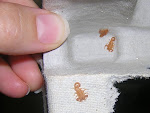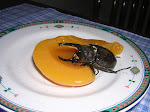Monday, February 16, 2009
Final Call for the 2009 GBBC
Got 15 minutes? Wanna watch some birds, see your results posted online, and further conservation efforts...all from your backyard? Well, you have one more day to do it. The Great Backyard Bird Count, a project by the National Audubon Society and the Cornell Lab of Ornithology, runs Feb. 13-16, 2009. Anyone can participate: novice and expert birders, kids and adults, adults who are still kids...
I posted on this last year, but was remiss in doing so in advance this year. Nevertheless, I'll be taking a short time out Monday morning 2/16, or sometime late afternoon (when the birds are most visible) to jot down all avian visitors to the Veggy House in Corvallis, OR. I hope you'll join me with a bird count from your neck of the woods.
For more information on the Great Backyard Bird Count:
How to Participate
Submit your Bird Checklist
Thursday, February 12, 2009
Darwin's Day
Today is the 200th birthday of Charles Darwin. Dr. Chris Marshall, Curator and Collector for the Oregon State Arthropod Collection, shows his appreciation for Darwin each year on Feb. 12th with some kind of nature-themed cake.
I snuck into the Zoology Department lounge to capture a picture of this year's creation... I found a tree stump made of sugar and eggs, lit afire, with a room full of brilliant minds singing to it. I wonder what Darwin would have said about this?
I snuck into the Zoology Department lounge to capture a picture of this year's creation... I found a tree stump made of sugar and eggs, lit afire, with a room full of brilliant minds singing to it. I wonder what Darwin would have said about this?
Saturday, February 7, 2009
Up for Air
Hello blogosphere, I'm still alive! That's the good news. And I'm learning by leaps and bounds. Several of my less well thought out ideas for posts never made it past draft one, lacking enough available brain cells and time will do that. But here's some of the funner stuff I have been up to as an Oregon State University grad student in the Entomology Program this winter '09:
My aquatic entomology course went collecting in local rivers and streams most Saturdays in January. Here are a few of the more neat looking aquatic insects I've sorted from my samples so far:
 Center three insects: Mayflies (order Ephemeroptera).
Center three insects: Mayflies (order Ephemeroptera).
A pretty pink Heptageniid at 11 O'clock, and two Ephemerellids.
This is how you capture them using: a D-net (so named, I think, because it's shaped like a "D"). The straight part of the net's frame (i.e., the stem of the "D") lays flush against the stream bed. By kicking the substrate (gently!) upstream of the net, insects become dislodged and the current carries them into your net. Like this:
Next: you empty the contents of your net into a bucket or bowl with water. This is where it gets fun, where the crazed look of gambling and greed not uncommon in casinos begins to take over... You never know what each sample will turn up. You can hope, and even guess based on the river or stream and where at within-stream you sample from. But you never know for sure what kind of cool critter will go swimming past your forceps...and there are always surprises! Adventure in a bucket.
 The aquatic entomology class, OSU '09.
The aquatic entomology class, OSU '09.
To snap us out of sampling, our instructor bribed us with donuts back at the van.
Impact to streams is neglible (we were assured); one insect may lay hundreds of eggs, and there seem to be innumerable insects in healthy streams...
The purpose of all this crazed gambl -- er, colleting? The simple answer: it's 40% of our course grade (along with the proper identification of the insects for our collection). In the real world beyond grad school, aquatic insects can help piece together information about what's going on in a particular river or stream or watershed. What is found (diversity), how many of them are found (abundance), and what life stage they're in (development, growth) is actually pretty useful for making determinations that guide fisheries managers, watershed projects, city planners, and of course a variety of conservation efforts. Learning about aquatic entomology and its usefulness as a tool in this way is why I am in grad school.
And this was my Friday night:
....No complaints from me. I wouldn't have it any other way.
My aquatic entomology course went collecting in local rivers and streams most Saturdays in January. Here are a few of the more neat looking aquatic insects I've sorted from my samples so far:
 Center three insects: Mayflies (order Ephemeroptera).
Center three insects: Mayflies (order Ephemeroptera).A pretty pink Heptageniid at 11 O'clock, and two Ephemerellids.
This is how you capture them using: a D-net (so named, I think, because it's shaped like a "D"). The straight part of the net's frame (i.e., the stem of the "D") lays flush against the stream bed. By kicking the substrate (gently!) upstream of the net, insects become dislodged and the current carries them into your net. Like this:
Next: you empty the contents of your net into a bucket or bowl with water. This is where it gets fun, where the crazed look of gambling and greed not uncommon in casinos begins to take over... You never know what each sample will turn up. You can hope, and even guess based on the river or stream and where at within-stream you sample from. But you never know for sure what kind of cool critter will go swimming past your forceps...and there are always surprises! Adventure in a bucket.
 The aquatic entomology class, OSU '09.
The aquatic entomology class, OSU '09. To snap us out of sampling, our instructor bribed us with donuts back at the van.
Impact to streams is neglible (we were assured); one insect may lay hundreds of eggs, and there seem to be innumerable insects in healthy streams...
The purpose of all this crazed gambl -- er, colleting? The simple answer: it's 40% of our course grade (along with the proper identification of the insects for our collection). In the real world beyond grad school, aquatic insects can help piece together information about what's going on in a particular river or stream or watershed. What is found (diversity), how many of them are found (abundance), and what life stage they're in (development, growth) is actually pretty useful for making determinations that guide fisheries managers, watershed projects, city planners, and of course a variety of conservation efforts. Learning about aquatic entomology and its usefulness as a tool in this way is why I am in grad school.
And this was my Friday night:
....No complaints from me. I wouldn't have it any other way.
Subscribe to:
Comments (Atom)




+reduced.jpg)

